A sensor is a device that measures physical input from its environment and converts it into data.
Sensors are an integral part of modern living. If you are reading this article on a computer, you are most likely using a mouse, which contains an optical sensor. If you are on a smartphone, you are using touch sensors every time you touch the screen. But what exactly is a sensor?
A sensor is a device that measures physical input from its environment and converts it into data that can be interpreted by either a human or a machine. Most sensors are electronic (the data is converted into electronic data), but some are more simple, such as a glass thermometer, which presents visual data. People use sensors to measure temperature, gauge distance, detect smoke, regulate pressure and a myriad of other uses.
__________________________________________________________________________
There are two types of electronic sensors: analog and digital. Analog sensors convert physical data into an analog signal. Analog sensors are much more precise than digital sensors, which are limited to a finite set of possible values. Below is a chart showing the difference between analog and digital signals:

Because analog signals are continuous, they can account for the slightest change in the physical variable (such as temperature or pressure). Digital signals, while following the general trend of variation, are restricted to fixed data (ones and zeros).
There are a multitude of types of sensors. In the average automobile alone, there are dozens of different types of sensors. Tire pressure sensors indicate whether a tire is flat or in need of more air. Self-driving cars such as the Tesla are equipped with ultrasonic sensors that measure the distance between the vehicle and other objects in its environment using sound waves. Home security systems use motion sensors, which detect the movement of primarily larger objects. The most commonly used motion sensor for home surveillance is called a Passive Infared (PIR) system, which detects infrared radiation in the sensor’s environment.
Sensor technology is also used frequently in medical devices. Input sensors such as myo-electrodes are used in prosthetic technology. Myo-electrodes detect electrical signal from a patient’s muscle contractions. Heartbeat sensors monitor and detect patients’ pulse, and thermometers measure temperature.
______________________________________________________________
What is Sensor?
A device that gives an output by detecting the changes in quantities or events can be defined as a sensor. In general, sensors are termed as the devices that generate an electrical signal or optical output signal corresponding to the variations in the level of inputs. There are different types of sensors, for example, consider a thermocouple which can be considered as a temperature sensor that produces an output voltage based on the input temperature changes.
One can observe many kinds of sensors in many domains employed for various applications. Let us consider a few of the types of sensors.
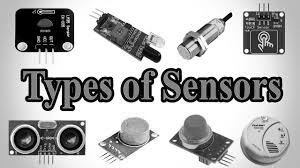
Different Types of Sensors in Electronics
In our day-to-day life, we are habituated to implement different types of sensors frequently in our power systems such as electrical and electronics appliances, load control systems, home automation or industrial automation, and so on.
All types of sensors can be basically classified into analog sensors and digital sensors. But, there are a few types of sensors such as temperature sensors, IR sensors, ultrasonic sensors, pressure sensors, proximity sensors, and touch sensors are frequently used in most electronics applications.
- Temperature Sensor
- IR Sensor
- Ultrasonic Sensor
- Touch Sensor
- Proximity Sensors
- Pressure Sensor
- Level Sensors
- Smoke and Gas Sensors
Temperature Sensor
Temperature is one of the most commonly measured environmental quantities for different reasons. There are different types of temperature sensors that can measure temperature, such as a thermocouple, thermistors, semiconductor temperature sensors, resistance temperature detectors (RTDs), and so on. Based on the requirement, different types of sensors are used for measuring temperature in different applications.
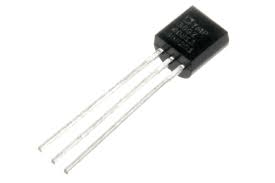
Temperature Sensor Circuit
A simple temperature sensor with the circuit can be used for switching on or off the load at a specific temperature which is detected by the temperature sensor (thermistor is used here). The circuit consists of the battery, thermistor, transistors, and relay which are connected as shown in the figure.
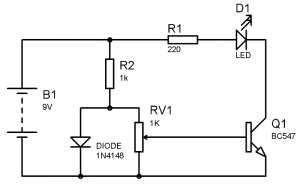
The relay is activated by the temperature sensor by detecting the desired temperature. Thus, the relay switches on the load connected to it (the load can be AC or DC). We can use this circuit for controlling the fan automatically based on temperature.
Practical Application of Temperature Sensor
Primarily, consider temperature sensors which are again classified into different types of sensors such as thermistors, digital temperature sensors, and so on.
The programmable digital temperature controller is a practical embedded system based electronic project it is designed, that is used for controlling the temperature of any device based on the requirement of industrial applications. The digital temperature sensor circuit kit is shown in the figure below.
The project circuit block diagram can be represented as follows with different blocks as shown in the figure.
The power supply block consists of an AC 230V supply, step down transformer for stepping down the voltage, a rectifier for rectification of voltage from AC to DC, voltage regulator for maintaining constant output DC voltage for giving input to the project circuit.
The LCD display is interfaced to the 8051 microcontrollers for displaying the temperature readings in the range of -55degrees C to +125degrees C. The digital temperature sensor IC DS1621 is used for providing 9-bit temperature readings to the microcontroller.
The EEPROM non-volatile memory is used to store user-defined (maximum and minimum) temperature settings through a set of switches to the 8051 microcontrollers. A relay is connected to the microcontroller which can be driven using the transistor driver. The load can be driven using this relay (here load is represented as a lamp for demonstration purpose).
IR Sensor
The small photo chips having a photocell which are used to emit and detect the infrared light are called as IR sensors. IR sensors are generally used for designing remote control technology. IR sensors can be used for detecting obstacles of the robotic vehicle and thus control the direction of the robotic vehicle. There are different types of sensors that can be used for detecting infrared lights.
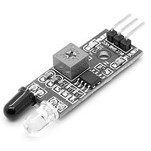
IR Sensor Circuit
A simple IR sensor circuit is used in our day-to-day life as a remote control for a TV. It consists of IR emitter circuit and IR receiver circuits which can be designed as shown in the figure.
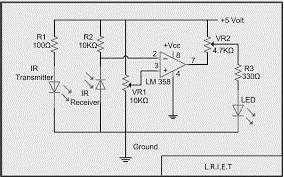
The IR emitter circuit which is used as a remote by the controller is used for emitting infrared light. This infrared light is sent or transmitted towards the IR receiver circuit which interfaces to the device like a TV or IR remote-controlled robot. Based on the commands received the TV or robot is controlled.
Practical Application of IR Sensor
IR sensors are frequently used to design TV remotes. It is a simple IR sensor-based electronics project used for controlling a robotic vehicle remotely using the general TV remote or IR remote. The IR sensor-controlled robotic vehicle project circuit is shown in the figure.
The block diagram of IR-controlled robotic vehicles consists of different blocks such as motors and motor diver interfaced with the 8051 microcontrollers, battery for power supply, IR receiver block, and TV remote or IR remote as shown in the figure.
Here, the IR sensor-based TV remote is used for sending commands to the robotic vehicle remotely by the user. Based on the commands received by the IR receiver interfaced to the microcontroller at the receiver end. The microcontroller generates appropriate signals to drive the motors such that to control the direction of the robotic vehicle in forward or backward or left or right.
Ultrasonic Sensor
A transducer that works on the principle similar to the sonar or radar and estimate attributes of the target by interpreting is called an ultrasonic sensors or transceivers. There are different types of sensors that are classified as active and passive ultrasonic sensors that can be differentiated based on the working of sensors.
The high-frequency sound waves generated by active ultrasonic sensors are received back by the ultrasonic sensor for evaluating the echo. Thus, the time interval taken for transmitting and receiving the echo is used for determining the distance to an object. But, passive ultrasonic sensors are just used for detecting ultrasonic noise which is present under specific conditions.
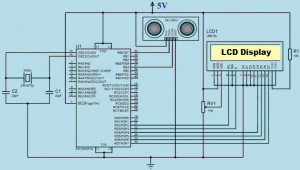
The ultrasonic module shown in the above figure consists of an ultrasonic transmitter, receiver, and a control circuit. The practical application of an ultrasonic sensor with the circuit can be used as an ultrasonic distance sensor circuit as shown below.
Whenever power supply is given to the circuit, then ultrasonic waves are generated and transmitted from the sensor and reflected back from an obstacle or an object ahead of it. Then, the receiver receives it and the total time taken for sending and receiving is used for calculating the distance between the object and sensor. The microcontroller is used for processing and controlling entire operations using programming techniques. The LCD display is interfaced to the circuit for displaying the distance (generally in cm).
Practical Application of Ultrasonic Sensor
Ultrasonic sensors with circuits can be used for measuring the distance of an object. This method is used, where we cannot implement the conventional methods to measure like inaccessible areas such as high temperature or pressure zones, etc. The ultrasonic sensor-based distance measurement project circuit kit is shown in the figure.
The distance measurement by the ultrasonic sensor project circuit block diagram is shown in the block diagram below. It consists of different blocks such as a power supply block, LCD display, ultrasonic module, an object whose distance has to be measured, and the 8051 microcontrollers.
The ultrasonic transducer used in this project consists of an ultrasonic transmitter and receiver. The waves transmitted from the ultrasonic transmitter are reflected back to the ultrasonic receiver from the object. The time taken for sending and receiving back these waves is calculated by using the velocity of sound.
Touch Sensor
Touch sensors can be defined as switches that are activated by the touch. There are different types of touch sensors that are classified based on the type of touches such as capacitance touch switch, resistance touch switch, and piezo touch switch.
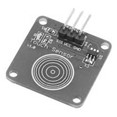
Touch Sensor Circuit
The circuit represents a simple application of a touch sensor that consists of a 555 timer operating in monostable mode, touch sensor or plate, LED, battery, and basic electronic components.
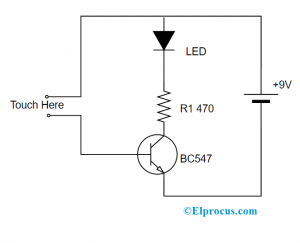
The circuit is connected as shown in the above figure. During normal state, when the touch plate is not touched, then the LED remains in the off state. If once the touch plate is touched, then a signal is given to the 555 timers. By sensing the signal received from the touch plate, the 555 timer activates the LED and thus the LED glows indicating the touch made to the touch sensor or plate.
Practical Application of Touch Sensor
A touch-sensitive load is designed for controlling the load. The touch-controlled load switch project circuit kit is shown in the figure.
Touch sensor principle-based touch-controlled load switch consists of different blocks such as power supply block, 555 timers, touch sensor plate or touch plate, relay, and load as shown in the block diagram of touch-controlled load switch.
The 555 timers used in the circuit are connected in monostable mode, which is used to drive a relay for switching ON a load for a fixed time duration. The trigger pin of the 555 timers is connected to the touch plate, thus, 555 timers can be triggered by touch. Whenever 555 timers are triggered by touch (voltage develops with human body touch) it delivers logic high for a fixed time interval. This fixed time can interval can be changed by changing the RC time constant connection to the timer. Thus, the output of the 555 timer drives the load through the relay and the load turns off automatically after a fixed time duration.
Similarly, we can develop simple and innovative electrical and electronics projects using more advanced sensors such as a PIR sensor-based automatic door opening system. Pressure sensor-based electricity generation which can be implemented by placing the piezoelectric plates (these are one type of pressure sensors) under a speed breaker on highways for generating electricity for highway street lights. Proximity sensor-based proximity detector circuit.
Now, let us move ahead and know types of sensors based on each domain such as in IoT, robotics, building, and across many industries.
Sensors in IoT
IoT is the platform where un recent times it stands as the center scope for all technology-related things. The function of IoT is to deliver multiple types of information and intelligence through implementing various kinds of sensors. These sensors operate to gather information, function on it, and sharing across multiple connected devices. With all the gathered information, the sensors allow for automatic functionality and making the technology smarter. Below are the types of sensors in the IoT domain.
Proximity Sensors
This a type of IoT sensor where it identifies the existence or non-existence of the surrounding object or finds the object properties. Then it converts the detected signal into the form that is clearly understood by the user or might be a simple electronic device that gets in no contact with them.
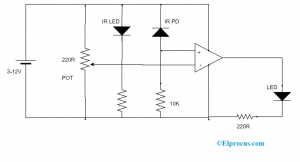
The application of proximity sensors is mainly in the retail domain where they can find out the movement and association that exists between the product and the consumer. With this users can receive quick notifications of discount updates and exclusive offers of interesting products. And the other domain is in automobiles.
For instance, when you reverse a car, you will be getting sounds if any obstacle is found, and here the operation of the proximity sensor is implemented.
There are many other types of proximity sensors and those are:
- Capacitive sensors
- Inductive sensors
- Photoelectric sensors
Chemical Sensor
These sensors are implemented in various industries. The main objective of these sensors is to signify any kind of changes in the liquid or to detect any air chemical variations. These are crucially implemented in bigger towns and cities because it is important to look for changes and provide safety for the population.
The essential implementation of chemical sensors can be seen in commercial atmospherical observation and to process management which can be either intentionally or fortuitously evolved chemicals, dangerous or radioactive exposure, reusable operations in space stations, pharmaceutical industries, and many others.
The most generally used chemical sensors are
- Electrochemical gas type
- Chemical FET
- Chemi resistor
- Non-dispersive IR
- pH glass electrode type
- Zinc oxide nanorod
- Fluorescent chloride type
Gas Sensor
These are almost the same as chemical sensors but are exclusively implemented to observe modifications of the quality of the air and to find out the existence of different types of gases. Similar to chemical sensors, these are employed in multiple domains like agriculture, health, manufacturing and utilized for air quality observing, recognition of toxic or flammable gas, dangerous gas supervision in coal industries, oil & gas businesses, chemical laboratory investigate, engineering – paints, plastics, rubber, medicinal & petrochemical, and others.
A few of the most implemented gas sensors are of
- Hydrogen type
- Ozone monitoring type
- Hygrometer
- Carbon-dioxide sensor
- Electrochemical gaseous type
- Catalytic bead type
- Air pollution type
- Carbon monoxide detection type
- Gas detection type
This is all about gas and chemical sensors and their types.
Humidity Sensors
Humidity is the term that is specified as the amount of vapor that exists in the atmospheric air or in other gaseous substances. Humidity sensors generally adhere to the utilization of temperature sensors as because most of the manufacturing operations need exact operating conditions. With the measurement of humidity, one can make sure that the entire procedure goes easily and when there occurs abrupt modification, then they go with immediate action as these sensors identify the variation more quickly.
Many of the domains such as residential, commercial use these humidity sensors for the purposes of heating, ventilation, and cooling purposes. Even these sensors can be observed in many other domains such as painting, hospitals, pharmaceutical, meteorology, automobile, greenhouses, and coating industries.
These are the mainly used types of sensors in the IoT domain.
Sensors in Robotics
Sensors hold more importance in the robotics industry as they allow the robot to be informed of the surrounding environment and so facilitate it to go with the necessary operations. Without the implementation of these sensors, robots can perform only a few monotonous activities that restrict robot capability.
With all these abilities, robots can perform many high-level operations. Let us discuss more clear about various types of sensors in robotics.
Acceleration Sensor
This type of sensor is employed to calculate angular and acceleration values. An accelerometer is mainly used for the calculation of acceleration. There exist two types of forces that show the impact on an accelerometer and those are:
Static Force – This is the frictional force that exists between any two objects. With the calculation of gravitational force, one can know the tilting value of the robot. This calculation is helpful for robotic balancing, or to know either the robot has a driving motion on uphill or on a flat edge.
Dynamic Force – This is measured as the amount of acceleration that is necessary for the movement of an object. The calculation of dynamic force through an accelerometer defines either the velocity or speed rates for what the robot is having motion.
These accelerometer sensors are available in multiple configurations. The type of selection is dependent on the requirement of the industry. A few of the parameters that are to be checked in before proper sensor selection are bandwidth, type of output either digital or analog, the total number of axes, and the sensitivity.
The below picture shows the schematic diagram of an acceleration sensor.
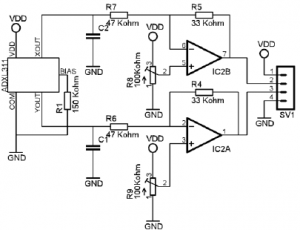
Sound Sensor
These sensors are usually microphone devices that are used to know the sound and deliver the corresponding level of voltage based on the detected sound level. With the implementation of a sound sensor, a small robot can be manufactured to navigate depending on the level of the received sound.
When compared with light sensors, the design process of sound sensors is somewhat complicated. This is because sound sensors deliver very minimal voltage difference and this has to be amplified to provide measurable voltage variation. The sound sensor switching circuit is shown below:
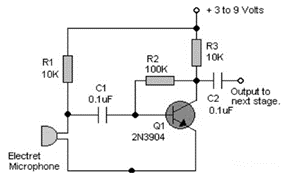
Light Sensor
Light sensors are kind of transducer devices that are used for identifying light and generates a voltage change which is the same as the intensity of light that comes under the light sensors.
There exist mainly two types of sensors in the robotics industry and those are photoresistor and photovoltaic. Even there are other types of light sensors those are not much implemented like phototransistor and phototubes.
Photo Resistor
This is a kind of resistor mainly employed for the purpose of light detection. In this, the resistance value gets changed in correspondence to the intensity level of light. The light that falls on the photoresistor has an inverse relation to the resistance value of the photoresistor. In most of the cases, the photoresistor is even termed as LDR which is Light Dependent Resistor. The circuit diagram of the photoresistor is shown as below:
Photovoltaic Cells
Photovoltaic cells are the energy transformation devices that are employed for the purpose of converting solar radiation into an electrical energy form. These are mainly used in the manufacturing process of solar robots. Separately photovoltaic cells are taken into consideration as energy source devices which is the application that is merged with both the capacitors and transistors and they can transform this into a sensor device.
Tactile Sensors
This is a type of sensor that states the contact that is in between the sensor and object. Tactile sensors are probably implemented in everyday scenarios such as in the lamps those dim or enhance brightness by touching their base and in lift buttons. In addition, there are many extensive applications of tactile sensors where people are not exactly aware. The major types of tactile sensors are
Touch Sensor
This is the sensor that holds the ability to sense and identify the touching of the object and the sensor. A few of the devices where the touch sensors are used are limiting switches, micro switches, and others. When any of the connectors get in contact with any of the solid sections, then this device will be handier and this stops the robotic movement. Furthermore, it is used for the purpose of inspection where it has a probe used for the component size measurement.
Force Sensor
This is utilized for measuring the force values of multiple operations such as machine unloading and loading, material carrying, and others that are operated by a robot. This sensor is also widely employed in the assembly approach to analyze the issues. There exist multiple approaches that are implemented in this sensor such as joint sensing, tactile array sensing.
Apart from these, there are many types of sensors in many industries. Let us a quick overview of those:
Types of Sensors used in Building
The mainly used sensors in the building industry are:
- Temperature sensors
- Motion Detection Sensors
- Electric voltage and current sensors
- Smoke and fire detection sensors
- Camera sensors
- Gas sensors
Types of Sensors in Remote Sensing
There exist mainly two types of remote sensing sensors and those are active and passive sensors.
Active Sensors
These generate energy to scan the things and locations and then a sensor identifies and calculates the amount of either backscattered or reflected radiation from the target object. The examples of active sensors are RADAR and LIDAR where the time difference that is in between the emission process and return process is calculated by determining the area, speed, and object direction.
Passive Sensors
These sensors collect radiation which is either radiated or reflected by the surrounding locations or object. The most crucial example of a passive sensor is reflected sunlight. And the other examples are radiometers, charge-coupled objects, infrared, and film camera work.
The classification of sensors in remote sensing are
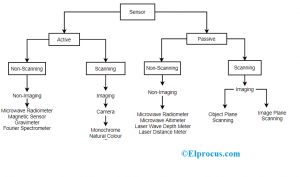
For designing different types of sensor-based circuits you can download our free eBook to design electronics projects on your own. You can also approach us for technical help by posting your ideas in the comments section below. Here is a question for you, what are other types of sensors and mainly circuit design of flow sensors?
_______________________________________________________--










